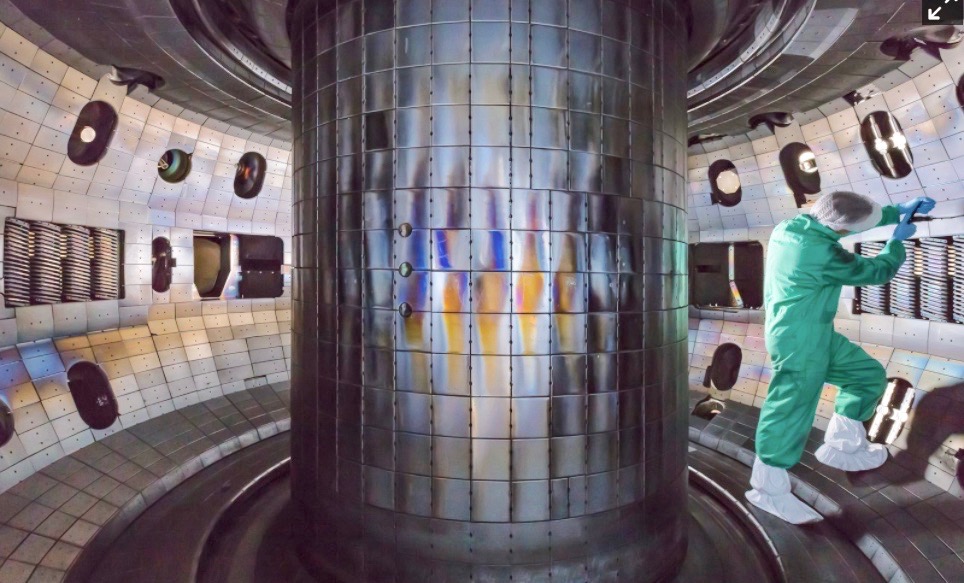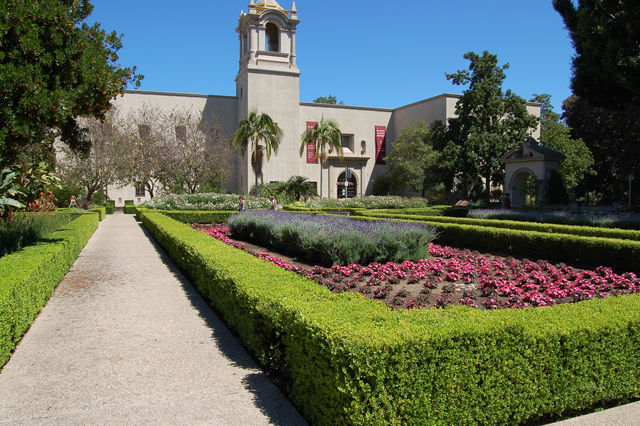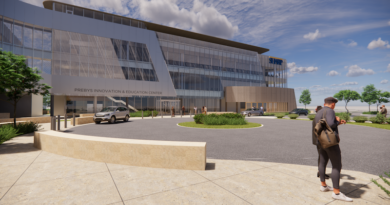Daily Business Report-January 4, 2021
An employee works at the DIII-D National Fusion Facility that General Atomics operates for the Department of Energy. (Photo courtesy of General Atomics)
Nuclear fusion group aims to build pilot plant
For the first time, a major group of American scientists has agreed to work toward opening a nuclear fusion plant by the 2040s. The timeframe is intentional, letting scientists work on and learn from giant projects like Europe’s ITER and China’s EAST before designing a prototype of a fusion plant for the United States.
The call for the fusion pilot plant came in an 80-page report written by the Fusion Sciences Advisory Committee.
This plan coalesced around goals put out by the U.S. Department of Energy’s (DOE) Fusion Energy Sciences (FES) department. Their strategic goals explicitly include fusion energy: “Advance the fundamental science of magnetically confined plasmas to develop the predictive capability needed for a sustainable fusion energy source.”
__________________________________________________

3 new county supervisors to be sworn in this morning
The swearing-in of three new county supervisors will take place virtually on Monday, Jan. 4. The newest members of the five-member board will take the oath of office in the numerical order of their districts.
10 – 10:20 a.m. – Supervisor-elect Nora Vargas for District One
10:20 – 10:40 a.m. – Supervisor-elect Joel Anderson for District Two
10:40 – 11 a.m. – Supervisor-elect Terra Lawson-Remer for District Three
The swearing-in will be virtual due to ongoing safety concerns about COVID-19. But the public can watch live on the County’s website, Facebook or on CNC-TV.
Cox Communications will air the swearing-in on channels 24 or 19. Spectrum will show the ceremony on channels 24 or 85.
For more information, visit the Clerk of the Board’s website or call 619-531-5434.
__________________________________________________
Port of San Diego and California State
Coastal Conservancy collaborate
to create a native oyster living shorline
The Port of San Diego is one step closer to creating a living shoreline to attract and establish native oyster populations while also protecting the shoreline from impacts related to future sea level rise. The first nature-based solution of its kind in San Diego Bay, the native oyster living shoreline pilot project and study is in collaboration with the California State Coastal Conservancy.
Installation of the native oyster living shoreline is expected to begin in spring 2021 adjacent to the Chula Vista Wildlife Reserve in south San Diego Bay. The project will use constructed reef elements to demonstrate the ability to attract and establish native oyster populations that create structurally complex “reef” habitat for fish, birds, inverts and aquatic plants. The project is also expected to improve local water quality via filtration and settling of sediments and also increase wetland connectivity to intertidal and subtidal lands.
After installation, the pilot project and the adjacent shoreline will be monitored and assessed for five years to capture the amount of growth of native oysters on the reef elements; learn about the presence and/or absence of non-native species on the reef elements; learn how the reef impacts or enhances local species richness of fish and mobile invertebrates within the project footprint; and determine the ability of the reef elements to catalyze sediment accretion or reduce erosion of sediment shoreward of the project.
__________________________________________________
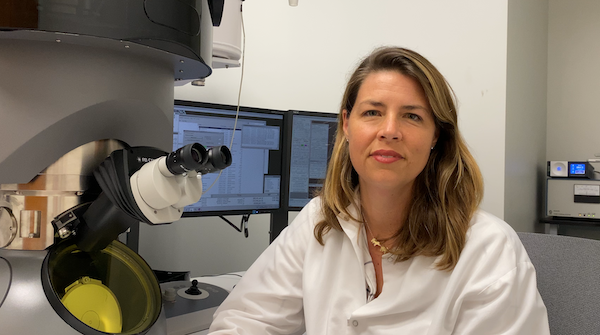
Erica Ollmann Saphire named Scientist of the Year
by ARCS San Diego
La Jolla Institute for Immunology Professor Erica Ollmann Saphire, Ph.D., has been named Scientist of the Year by ARCS San Diego, a chapter of the Achievement Rewards for College Scientists (ARCS) Foundation. The annual award recognizes Saphire’s breakthroughs in structural virology and her leadership of the Coronavirus Immunotherapy Consortium this year.
One San Diego scientist is recognized each year. Recent awardees include Paul Schimmel of Scripps Research, Karen Nelson, president of the J. Craig Venter Institute, and Rusty Gage, president of the Salk Institute.
Saphire and her lab members study the host-pathogen interface at the molecular level. Her work has shed light on global killers such as HIV, Ebola, Lassa, Marburg and SARS-CoV-2, the virus that causes COVID-19.
Saphire moved from Texas to San Diego to pursue her graduate studies in 1994. She went on to start her own lab at Scripps Research in 2003. In 2019, Saphire joined the LJI faculty as professor and led the Institute’s effort to establish a molecular imaging facility, which gives scientists cutting-edge tools to examine key proteins involved in disease.
Throughout her career, Saphire has been a leader in global efforts against viral diseases.
__________________________________________________
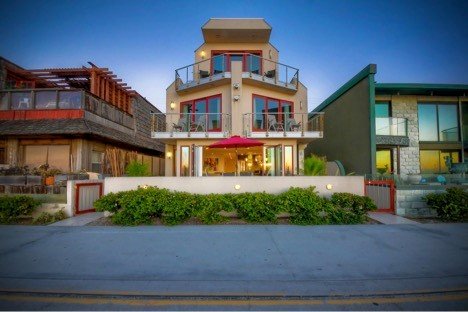
Oceanfront Mission Beach duplex
listed for $5.38 million
Tanya Jovanovic, an agent affiliated with the Encinitas/La Costa office of Coldwell Banker Realty, has listed an oceanfront Mission Beach duplex for $5.38 million. Located at 3363 Ocean Front Walk, the approximately 2,940-square-foot duplex includes six bedrooms and six bathrooms.
With no HOA or Mello-Roos, the three-story duplex contains an upper and lower unit with a total of four parking spots. Each unit contains three bedrooms, three bathrooms, kitchen, dining area, laundry closet, outdoo showers, garage, carport and private ocean view balconies from the master bedrooms.
Known as Decked Out One, the approximately 1,400-square-foot upper unit encompasses the second and third levels and features a private roof deck with hot tub overlooking views of Mission Bay and the ocean. Also, the great room has access to a private balcony, which was designed like the bow of a ship. Known as Decked Out Two, the nearly 1,540-square-foot lower unit includes the first and second levels and offers a spacious floor plan with a patio off the main deck.
__________________________________________________
Researchers discover a new
superhighway system in the Solar System
Researchers have discovered a new superhighway network to travel through the Solar System much faster than was previously possible. Such routes can drive comets and asteroids near Jupiter to Neptune’s distance in under a decade and to 100 astronomical units in less than a century. They could be used to send spacecraft to the far reaches of our planetary system relatively fast, and to monitor and understand near-Earth objects that might collide with our planet.
In their paper, published in the Nov. 25 issue of Science Advances, the researchers observed the dynamical structure of these routes, forming a connected series of arches inside what’s known as space manifolds that extend from the asteroid belt to Uranus and beyond. This newly discovered “celestial autobahn” or “celestial highway” acts over several decades, as opposed to the hundreds of thousands or millions of years that usually characterize Solar System dynamics.
“Simply put, these highways are entirely produced by the planets,” said Aaron Rosengren, a professor in the Department of Mechanical and Aerospace Engineering at UC San Diego, and one of the paper’s authors. “Asteroids, comets, etc., are candidates to travel along them, but do not produce their own ‘fast routes’. Jupiter, being the most massive body in our planetary system, is responsible for most of the structures we’ve discovered, but each planet generates similar ‘arches’ and all of these structures can interact to produce quite complicated routes for transport.”
__________________________________________________

Law barring retail sale of dogs,
cats and rabbits takes effect
City News Service via Times of San Diego
A law prohibiting the retail sale of dogs, cats and rabbits in California took effect Friday.
AB 2152, known as Bella’s Act, was sponsored by the San Diego Humane Society and written by Todd Gloria, San Diego’s new mayor, when he was still a state assemblyman.
The legislation aims to end the practice of selling animals bred and raised in unhealthy, inhumane conditions in out-of-state puppy mills that supply pet stores. The act was named for Bella, a corgi bred in a puppy mill who had been advertised as a rescue dog in a San Diego pet store and sold for thousands of dollars billed as her adoption fee.
During that experience, Bella was declawed and developed a severe case of bronchitis, which cost her new owner thousands of dollars in prolonged veterinary care to get her healthy.
Bella’s Act officially closed a loophole in AB 485, which took effect in January 2019 and made important progress, but allowed those seeking to continue to profit from imported mill-bred animals to circumvent the intent of the law.
Pet store owners exploited a provision in AB 485 allowing them to sell dogs, cats and rabbits if they entered into a cooperative agreement with a shelter or rescue organization by partnering with insincere “rescues” or unsuspecting shelters.
San Diego Humane Society’s Humane Law Enforcement officers ended up citing several stores for various violations including improper signage and not having a valid cooperative agreement.
“With Bella’s Act going into effect, we’ll be able to end the inhumane retail sales of dogs, cats and rabbits in California once and for all,” said Bill Ganley, San Diego Humane Society chief of humane law enforcement. “Pet stores will still be allowed to provide space for shelter or rescue animals and adopt them out, as long as they are sterilized and the adoption fee do not exceed $500. It is a win-win.”

